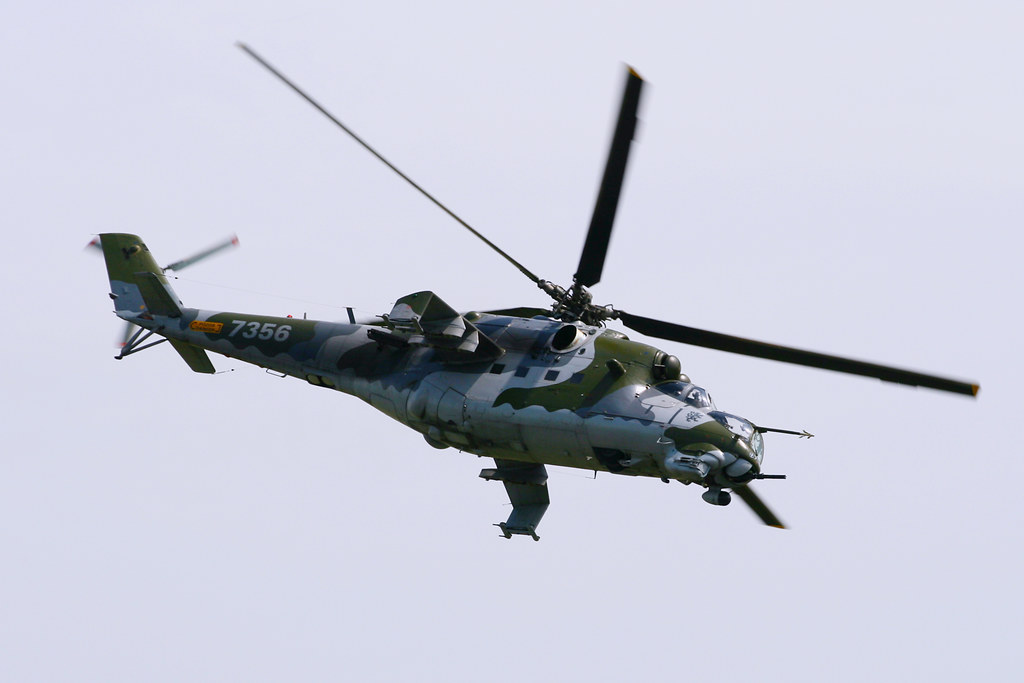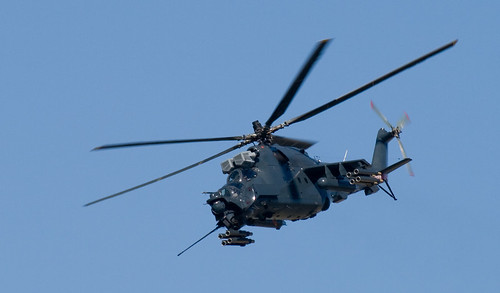




modernized Mi-24 with thermal sights, rotor elements from Mi-28 and double barrel cannon 23mm GSh-23 Russian army attack helikopter Mi-35M HIND
(FILES) Picture taken 27 August 2004 of a couple of Russian-made Mi-24 assault helicopters firing AT missiles during joint Russian-Armenian military maneuvers in Armenia. Venezuela signed at the end of 2006 a contract with Russia to buy 24 Sukhoi-30 multi-rol aircrafts and 53 Mi-24 helicopters, among other weapons. US director of national intelligence Michael MaConnell said 27 February, 2007 that the purchase of weapons by Venezuela may increase the arms race in Latin America. AFP PHOTO / HAKOB BERBERYAN / ARMINFO
Mi 24 Super Hind Helicopter at Ysterplaat Airshow, Cape Town
Georgia Air Force - Mil Mi-24 - Миль Ми-24 - Hind
I think it is one the Hinds that we bought from the former Soviet States. We use to have a hind and a Ka-25 fly through. Awesome helicopter, heavy armor.
Armed to the teeth

The well known MI-24 [think Rambo movies, although I think that the Rambo ones were the big MI-35's]. Russian attack helicopter. South African Vodka : MI-24
Thursday, August 20, 2009
mil mi 24 hind helicopter gunship picture gallery
Subscribe to:
Post Comments (Atom)






3 comments:
it was becoming apparent that the use of large mechanized and armor forces did not constitute a strategy for victory. During this period, airpower began to play an increasing role as a "force substitute" in Soviet efforts to eliminate the mujahideen insurgency while minimizing their own casualties. At the beginning of 1981, the VVS air order of battle included approximately 130 jet fighters, predominantly MiG-21 Fishbeds, MiG-23 Floggers, and Su-17 Fitters among a total of 300 fighter aircraft and transports.30 In addition, the Soviets maintained a force of about 600 helicopters in Afghanistan. Helicopters, including Mi-6 Hook and Mi-8 Hip transports and, especially, Mi-24 Hind gunships proved invaluable to the Soviet strategy, and became the single most significant weapon in the Russian arsenal. The diverse range of helicopter missions in Afghanistan included close air support, forward air control spotting for fixed-wing aircraft and artillery, troop transport and resupply, medevac, chemical weapons delivery and reconnaissance.The importance of attack and transport helicopters in combating the insurgency cannot be overstated. Former Afghan General Mohammed Y. Nawroz and American intelligence analyst Lester W. Grau argued that "Without the helicopter gunship, the Soviets may have withdrawn years earlier. Its firepower and mobility and initial invulnerability put the guerrillas on the defensive. The Soviets used helicopters extensively and ruthlessly against the unprotected guerrillas In the rugged mountains of Afghanistan and along the border caravan routes, the Mi-24 Hind essentially became a "flying tank," capable of providing massive firepower in support of ground operations or acting as a lethal instrument for aerial interdiction.the insurgents, lacking the weapons with which to combat the heavily armed Mi-24 Hind effectively, "feared them more than anything else."36 The armored Mi-24 was indeed a formidable weapons system with its 12.7-mm machine gun, guided missiles and 128 57-mm rockets.
By the beginning of 1986, the mujahideen had clearly demonstrated an increased ability to combat Soviet airpower, and had forced Russian jets to operate at higher altitudes thereby decreasing their accuracy. The greater number of heavy machine-guns among the insurgents also led to an increasing capability to threaten the mainstay of Soviet aviation in Afghanistan, their helicopters. The Mi-24 Hind, almost impervious to small arms fire, was vulnerable to concentrated fire from both heavy machine-guns and the SA-7. In the end, the numbers tell the story. One Afghan defector estimated DRA aircraft losses between December 1979 and early 1984 at 164 aircraft (both fixed-wing and helicopter).78 Joseph J. Collins, a former US army officer, estimated that by the end of 1984 Soviet losses totaled 600 aircraft.79 The balance of power began to shift in favor of the insurgents as the mujahideen achieved their first successes in contesting Soviet dominance of the skies over Afghanistan in 1984 and 1985.
After a period of prolonged deliberation, the US government decided to supply the mujahideen with heat-seeking Stinger surface-to-air missiles (SAMs) in 1986. In hindsight, it is clear that both the psychological and physical impact of the Stinger proved enormous. The very presence of the missile, whether used to full effect or not, forced a fundamental alteration in the nature of Soviet air tactics throughout Afghanistan. The Stinger, however, constituted the second phase in attempts by the West to improve the organic air defense capabilities of the insurgents. Already in the beginning of 1986, the mujahideen received the first shipments of the British- manufactured Blowpipe manportable SAM. The optically guided Blowpipe proved large and unwieldy in the eyes of the insurgents. The Blowpipe required the operator to guide the missile with a thumb-controlled joystick while tracking the target with a monocular sight
By October 1986, the mujahideen had received approximately 200 Stinger missiles.97 The Stinger, with its maximum speed of 2.2 Mach and maximum effective range of 5.5 kilometers, provided a quantum leap in performance over the SA-7 with a maximum speed of 1.4 Mach and maximum effective range of 3 kilometers.98 More importantly, the Stinger was an all-aspect missile while the infrared passive homing SA-7 could only be launched from the rear quadrant of aircraft moving away from the missile operator.
the Stinger was by all indications a great improvement over the Blowpipe.
Daoud Rams, a former MiG-21 pilot with the Afghan air force, stated that "The Blowpipe missile didn't present as serious a problem to fighter aircraft as Stinger. Both Stinger and Blowpipe were real problems for helicopters, but we were more concerned with Stinger.
Deadly insect :)
Great wallpapers!The Russians definitely have a talent for building intimidating helicopters.These things are so incredibly mean looking
Post a Comment